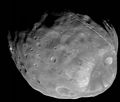Súbor:Phobos colour 2008.jpg

Veľkosť tohto náhľadu: 636 × 600 pixelov. Iné rozlíšenia: 255 × 240 pixelov | 509 × 480 pixelov | 815 × 768 pixelov | 1 086 × 1 024 pixelov | 2 172 × 2 048 pixelov | 3 500 × 3 300 pixelov .
Pôvodný súbor (3 500 × 3 300 pixelov, veľkosť súboru: 2,72 MB, MIME typ: image/jpeg)
História súboru
Po kliknutí na dátum/čas uvidíte ako súbor vyzeral vtedy.
| Dátum/Čas | Náhľad | Rozmery | Používateľ | Komentár | |
|---|---|---|---|---|---|
| aktuálna | 03:10, 2. apríl 2018 |  | 3 500 × 3 300 (2,72 MB) | Kaldari | more margin on right side |
| 04:47, 13. november 2008 |  | 3 374 × 3 300 (2,7 MB) | Fir0002 | == Summary == {{Information |Description=Colour image of Phobos, imaged by the Mars Reconnaisance Orbiter in 2008 |Source=NASA |Date=9 April 2008 |Location=http://www.nasa.gov/mission_pages/MRO/multimedia/pia10368.html |Author=NASA/J |
Použitie súboru
Na tento súbor odkazujú nasledujúce 3 stránky:
Globálne využitie súborov
Nasledovné ďalšie wiki používajú tento súbor:
- Použitie na af.wikipedia.org
- Použitie na an.wikipedia.org
- Použitie na ar.wikipedia.org
- المريخ
- فوبوس
- قمرا المريخ
- ويكيبيديا:صور مختارة/الفضاء والكون/نظرة إلى الأعلى
- قائمة أجرام المجموعة الشمسية مرتبة حسب الحجم
- بوابة:علم الفلك/صورة مختارة
- بوابة:المريخ
- بوابة:المريخ/مقالة مختارة/أرشيف
- بوابة:المريخ/مقالة مختارة/2
- قائمة الأقمار الطبيعية
- خط زمني لاكتشاف كواكب المجموعة الشمسية وأقمارها
- ويكيبيديا:ترشيحات الصور المختارة/القمر فوبوس
- ويكيبيديا:صورة اليوم المختارة/أغسطس 2019
- قالب:صورة اليوم المختارة/2019-08-03
- بوابة:علم الفلك/صورة مختارة/73
- معسكر قاعدة المريخ
- ويكيبيديا:صورة اليوم المختارة/يناير 2022
- قالب:صورة اليوم المختارة/2022-01-04
- Použitie na ary.wikipedia.org
- Použitie na arz.wikipedia.org
- Použitie na as.wikipedia.org
- Použitie na azb.wikipedia.org
- Použitie na az.wikipedia.org
- Použitie na be-tarask.wikipedia.org
- Použitie na be.wikipedia.org
- Použitie na bg.wikipedia.org
- Použitie na bh.wikipedia.org
- Použitie na bn.wikipedia.org
- Použitie na bn.wikibooks.org
- Použitie na bs.wikipedia.org
Zobraziť ďalšie globálne použitie tohto súboru.





